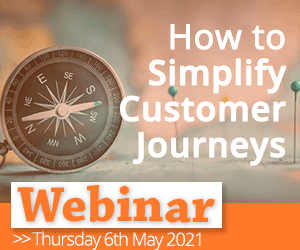Alex Loach provides a few pointers about how to improve customer engagement.
What we all want is to create a superior customer experience all day and every day.
If the focus is on convenience and quality, most other things will fall into line from this starting point. Here are 5 ways to make this happen.
1. Constant feedback is the key
Keeping customer relationships up to date means being customer centric, gaining as much feedback as possible, and therefore speaking with your customers as much as possible.
One way to do this is by conducting customer surveys on a weekly basis, especially to customers who have recently purchased from you.
However, it’s not just about those recent customers. For most businesses, it’s also about how easy to use their website is. On a quarterly to half-yearly basis, collate feedback about the site and what customers feel could be better, and then change it to make it more convenient.
Keep the data separate to gain a better insight, so survey both frequent customers and infrequent customers, and do not forget the customers who used to purchase from you but no longer do. Then spend the next three to six months focusing on five to ten different aspects that you can make better and more convenient for them.
2. Rate your own products
There are two lines of thought here with regard to rating your own products. The first is similar to ‘Amazon Recommendations’ but a step further, in that you can rate your products based on an individual customer’s past purchase (and if possible return) history.
The second line of thought is that if you deal with those products that can change in quality, such as fresh consumables, then this shows that you take quality seriously, and that you want to tell your customers whether the goods are in a ten out of ten, or maybe eight out of ten condition, for example.
What this is doing is steering your customers towards either what is best for them, or the best quality at the time, and, even more importantly, it shows that you take the quality of your goods or produce extremely seriously.
3. Green initiatives and customer engagement
These days, green initiatives have become more and more important, and many customers feel strongly about green issues.
Although these may not matter to a huge percentage of customers, the number is growing as the subject is more in the limelight, and no perspective is too small to be ignored. Whilst companies may feel that this is not very relevant to them and that it is more applicable to industrial units, in reality every effort, however small, makes a difference, and almost every company these days uses paper or cardboard, or sends emails, and is thinking about that little extra that can be done.
Paper and cardboard is an easy subject, but even emails (which themselves are considerably more green than sending letters or faxes) can include that little bit more, and it’s not rare to see as part of a company signature something along the lines of ‘Please remember the environment, and do not print this email off unless you really need to.’
Again, if you’re unsure what direction to take, then ask your customers. I guarantee some of them will have suggestions, or at least opinions about how you could do more. First you could move from standard boxes to recyclable boxes. Then to 100% recycled boxes, and then to making sure the goods fit the boxes perfectly so that they use no more packaging than necessary. This is all about looking at initiatives and making them work. Obviously, for abnormal orders, this isn’t that straightforward, but if 90% of your orders have 3 or fewer items in them, then concentrate on the packaging of these orders first.
Ideally, it would be great to get rid of certain boxes and containers altogether, as some companies such as ground coffee makers have already done, but if that’s not a viable option at this time, then just keep making small steps in the right direction and be as environmentally friendly as possible.
4. How do you use customer engagement online, and how do you measure it?
This starts with data, and the more of it you have, the better.
Include an individual’s entire order history, usage, customer contacts and data collated from surveys. All the data you can get your hands on. Then use this like Amazon do to create recommendations or, as mentioned earlier, to rate your products with regard to how much you think the customer would like it. For items that may be repeat purchases, such as food, clothes, stationery, etc. you can also always show them their favourites on the current page, allowing them to add it there and then. The smarter you can make this activity, the better it will engage the customer.
For example, if there is a particular type of shoe a customer often buys, show them these shoes. Then the next step is to add them at the size they always buy. Maybe the next step after that is to show them what customers with extremely similar purchasing patterns also buy.
For more complicated products, such as home entertainment products, do they normally buy high-end or budget products? Is there a particular brand that they often purchase? Do they have them in black or silver? Maybe instead of just showing an image of the product in question, you can show a video? The number of options for improving the information, ratings or recommendations that you provide in order to engage with your customers is almost never ending.
It’s all about making the experience very personalised, and engaging with customers each time they visit the website.
5. The effect of the economic environment on pricing and customer engagement
There is no getting away from the fact that the recent economic environment has affected some industries more than others.
People are travelling abroad less, and they are drinking and eating out less frequently than they used to. However, where these are negatives in some areas, there have been positive effects on holiday resorts within the country, or for stores who sell consumables for home use.
If you can afford to be diverse in the way you market and engage your customers to your products, then look for every little positive from every single negative.
Maybe you will sell fewer high-end products, but if you can recognise the trend early on and before your competitors, you might sell more of the budget products than you ever have.

Alex Loach
Alex Loach is Head of Customer Services at Serif (Europe) Ltd and is responsible for overseeing all service, support and fulfillment functions including providing insight and recommendations on how to improve other functions within the company to enhance overall customer experience. Alex has over ten years’ experience, largely within the call-centre environment. He has worked within sales teams, data analysis, quality assurance, warehouse functions, as well as customer service and technical support departments.
Do you have any tips for how to increase customer engagement? Please leave them
Author: Jo Robinson
Published On: 20th Nov 2012 - Last modified: 15th Aug 2025
Read more about - Customer Service Strategy, Customer Experience (CX), Service Strategy









































